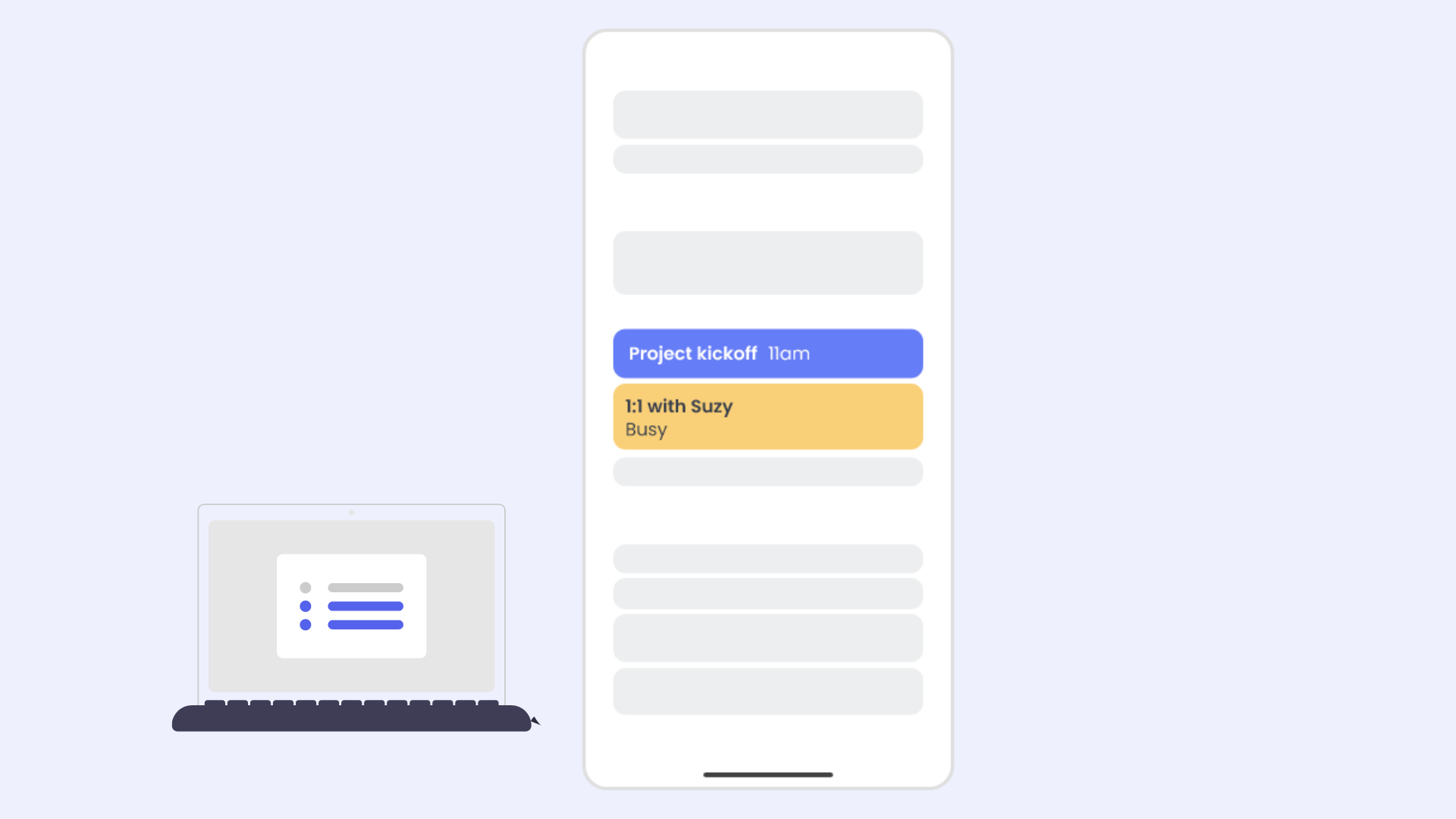
.png)
When you consider the average person spends one-third of their life at work, it’s obvious that job satisfaction is a major factor in supporting an overall happy life. But when you’re being asked to work late (again), getting called up on vacation days, or are dealing with a micromanager breathing over your shoulder – ‘job satisfaction’ can start to feel like quite the stretch goal.
And since we’re spending five out of seven days at the office, or logged on with the team – it’s the everyday things that often determine whether we end the week feeling fulfilled at work, or leave Friday feeling totally exhausted every week. Including factors like your relationships with the team, a healthy work-life balance, and even how many meeting-heavy your calendar is.
Even if you work at an amazing company that prioritizes work-life balance and employee happiness, boundaries are always up to you to set – so your coworkers know when you’re available, working on something important, or are on your personal time. You can’t blame your teammate for pinging you over lunch if it’s not on the calendar! So why is it that many professionals struggle with establishing boundaries at work?
In this blog post, we’re going to go over why personal boundaries are so important, and walk through 6 examples of healthy boundaries you can set at work today to immediately improve your work-life balance.
What are personal boundaries?
The concept of boundaries isn’t new, but the need has greatly increased due to major workforce trends around remote work, quiet quitting, and the great resignation in recent years.
But what exactly are boundaries? Personal boundaries are the limits you set to honor and protect your values and priorities. It’s time to draw your line in the sand – boundaries help express the kind of treatment you will (and will not) accept from others, and what you need to feel safe and respected – leading to more confident, emotionally stable, and less anxious teams. Here are some great examples of healthy personal boundaries at work:
Great examples of personal boundaries at work
- Physical boundaries: Not working on weekends, making time to eat lunch every day, and taking sick days when you’re ill (yes, even if you’re working from home).
- Mental boundaries: Signing off at 5pm, setting Do Not Disturb (DND) when you’re focusing on deep work, and taking a break after meetings to decompress.
- Emotional boundaries: Expressing that you’re uncomfortable with a coworker raising their voice at you, sharing your working hours and communication preferences with your team, and delegating tasks when you have too much on your plate.
There are many different kinds of personal boundaries including physical, emotional, time, sexual, intellectual, and material boundaries. All of these can look unique for different people, but all serve the same purpose of sharing how you want to be treated by others. Setting boundaries is important across all relationships in your life - whether that’s friendships, romantic relationships, with family - and also in the workplace, where we’re chipping away towards the roughly 90,000 hours we’ll put in over the course of our career.
Unfortunately, many people struggle with personal boundaries, often without even realizing it. For example, you may be trying to stay available on Slack 24/7 in case an urgent request comes in from a coworker, or responding to emails on PTO so you don’t hold your team up. The reality is, these people-pleasing tendencies often come from a place of insecurity. And sacrificing your own needs to prove yourself can take a serious toll on your wellbeing in the long-run. So how can you tell if you’re lacking boundaries? Let’s take a look at some common signs:
7 signs of poor personal boundaries
- You always put other people’s needs before your own, even if that means overextending yourself.
- You find yourself chronically drained or mentally exhausted at the end of the week and don’t know why.
- You have a hard time saying “no” to things you don’t have the time or energy for.
- You worry about coming across as ‘not nice’, and letting people down or disappointing them.
- You have a hard time making decisions for yourself because you worry about how it will affect other people
- You feel resentful towards others because you feel like you get taken advantage of.
Sadly, many adults were never taught how to express their needs and advocate for themselves. And if these examples hit close to home, you’re probably feeling pretty overrun and unhappy. A lack of boundaries is even more challenging if you’re struggling with imposter syndrome, or feel uncomfortable speaking up to your superiors. So where do you even begin in setting personal boundaries at work?
How to start setting boundaries at work
Between the major changes to the global workforce back in 2020, and dwindling teams thanks to The Great Resignation since – employees saw their workloads skyrocket. And as employees were assigned extra tasks and additional duties to make up for the gaps in the team, they also had to figure out how to get everything done – on top of the new stressors of navigating a fully remote or hybrid work model.
So employees ended up with crippling meeting fatigue, no time for high-value focused work, and were left feeling dissatisfied with their jobs. And this led to the rise in employee disengagement with movements like quiet quitting that put even more stress on the remaining workforce.
Ironically, a lack of healthy boundaries at work around time, capacity, and expectations negatively affects both employees and employers. Employees end up overrun and exhausted, and leadership struggles with unproductive and unmotivated teams. So how do you go about creating healthier work boundaries to help everyone succeed?
Setting healthy boundaries is a must if you want to stay productive, focused, and efficient at work – especially when you’re working from home where the lines of work and life are too often blurred. Let’s break down the three main areas for personal boundaries in the workplace.
Main 3 types of personal boundaries at work:
- Job responsibilities are the boundaries of your role that establish clear expectations and limits of your duties and responsibilities.
- Interpersonal relationships are the boundaries you set with others (like co-workers, managers, and direct reports) to feel safe and respected at work.
- Personal boundaries are the boundaries you set for yourself in order to maintain a healthy work-life balance that aligns with your individual priorities.
Establishing these boundaries as a manager and an employee - and learning to actually communicate and defend them - helps the entire team stay focused on priorities, align with personal and company values, and feel safe and respected on the team. Here are 6 examples of simple, yet effective, boundaries to start setting with your team to improve your work-life and productivity.
6 personal boundaries rules for you
1. Defend your time
Did you know the number one cause of employee burnout in 2022 was a lack of time for focused work? Reported by a staggering 63.4% of professionals across departments and roles. The reality is, meetings have increased 69.7% since February 2020, clogging up employees calendars and preventing them from getting through their actual work. The result? The majority of employees are working extra hours every week to keep up, with the average workweek for full-time employees clocking in at 47.6 hours (an additional 276.3 hours of work by the end of the year!).
‘This meeting could have been an email’ memes are a funny (not so funny) and relatable issue for today’s professionals. Blocking time on your calendar for things like deep work and personal commitments (like your healthy habits) is a great start to setting boundaries around your time, and prevent your week from being overrun by other peoples’ priorities.
So if you have a major project due by end of week, and need to dedicate at least half the workweek to it if you’re actually going to get it done – you need to put this time on the calendar! If not, why wouldn’t a colleague assume you’re free to help them get their important work done?
Calendar management apps like Reclaim.ai help automate this process, so you can build a flexible weekly work plan that ensures you have enough time for all your task work and regular routines – while still keeping you open for collaboration with your team.
2. Limit interruptions during focus time
As mentioned above, an essential part of setting boundaries is actually communicating them with your team. And where do so many of us communicate most? Over Slack. You can’t just expect your team to know when you’re busy working on an important task, in a meeting, or out at a doctor’s appointment if you’ve got the green active button hanging by your name in Slack. It’s basically a welcome sign for interruptions at work!
Setting your Slack status is an incredibly simple technique to let your team know what you’re doing so they don’t send you a poorly timed Slack message that pulls you out of your flow state. It’s also the best way to minimize interruptions from coworkers during your focus time so they know to connect with you later, or schedule-send their message to a later time. Don’t be afraid to take advantage of that Do Not Disturb (DND) settings when you’re really trying to stay focused – it’s there for a reason!
And if you want to automate this - because who has time to manually update their Slack status all day - you can automatically sync your Slack status to your calendar for free via Reclaim.ai. It keeps your Slack status updated in real-time with your schedule so everyone on your team knows when you’re available, and when you’re not.
3. Practice saying “no”
Learning to say “no” to requests that you just don’t have the bandwidth for is so important to setting boundaries in all areas of your life. But while it’s easier to fake a back injury to get out of helping your friend move again for the fifth year in a row, we often find it harder to say no at work. So when you’re asked to take a non-urgent task you definitely don’t have time for, are invited to a meeting you don’t need to be at, or are assigned new responsibilities way outside of your role requirements and compensation range, try saying “no” using this simple approach below.
Saying “no” doesn’t have to be rude – if you say it the right way! Instead of just declining without explanation, send a quick response to your coworker or manager to explain why you can’t prioritize the request right now. Here’s a good template you can work off of to fit your “saying no” scenario:
Hey [name], thanks so much for reaching out about [insert request]. I’d love to help, but I have to dedicate my [day/week] to prioritizing [insert project here] before our deadline on [date]. If this is urgent, I'd be happy to run it by [manager's name] to see if I can reprioritize time for it [today/this week/next week] in front of my other work."
See, you can say no without evening using the word “no”! So if you worry about coming across as unkind, or that you’re not a hard worker, simply explain that you have to prioritize other tasks on your plate. And if the request is coming from your manager? Here’s a good template to send back to clarify what you should be prioritizing:
Hey there, I’d love to help out, but I still have roughly [number of hours] hours left on [task 1], [task 2], and [task 3] that I’ve been prioritizing this week before our [due date] deadline. Let me know if [insert request] is higher-priority, and I’d be happy to switch gears!
Using a simple response that transparently communicates your current workload will not only help you balance your day, but allows your manager to see what you actually have bandwidth for to align your efforts where they’re needed the most. It’s a great way to reduce friction and tension with your boss and improve your working relationships.
The reality is, taking on more than you can realistically handle isn’t selfless – it’s self-sabotage. Planning your time and energy means prioritizing your responsibilities and communicating when something doesn’t align with those goals. Tools like the Eisenhower Matrix can help you get clear on your priorities.
4. Be honest about your feelings and needs
Like learning to say “no”, expressing your needs and boundaries might seem like a daunting feat. An important thing to remember is that your superiors want you to perform at your best – and sharing your struggles helps them support your long-term motivation and productivity.
Job burnout hurts everyone on the team, so let your manager know when you’re feeling overrun at work, need some extra support, or if you actually thrive under a different management style than the one they’re using. Often, the best time to have these conversations is in your one-on-one meetings by transparently sharing your workload, blockers, availability, and where you could use some help. If you’re dealing with a micromanager, let them know that you’d like some more independence on projects, or would prefer feedback in a different format (constructive vs. critical), so you can work on improving your approach in a more productive way.
And if you’re on the managerial side of this – be proactive with your check-in questions to see how your reports are doing so you can help them be more successful in their role, and stay open to feedback from your team on how you can grow as a leader.
5. Stand up for yourself when boundaries are crossed
Your boundaries are only as strong as you defend them. And even when you effectively communicate your boundaries and needs – you might run into people who won’t respect them.
Asserting yourself when someone is overstepping boundaries at work is crucial to protecting the integrity of how you let others treat you. This means clearly communicating your boundaries, and following through with consequences when a boundary is crossed.
For example, say your coworker keeps pinging you to ask “do you have a minute to chat?” or “can you help me with this quick?” during your personal hours. Here are a few tips for effectively defending a personal boundary:
Repeat your boundary clearly: Clearly state your boundary and its parameters to eliminate any room for misinterpretation.
- ❌ Vague boundary: Hey, I actually finish work at 5pm but what did you need help with?
- ✅ Clear boundary: Hey, quick reminder my working hours are 9am-5pm EST. I’m generally not able to respond to messages outside of this time frame (unless it’s an emergency), but I’d be happy to chat tomorrow when I’m back online.
Don’t over-explain yourself: If they’re still not getting it? You don’t need to over-explain your boundary. Address violations on the spot to make sure they’re aware of a crossed line.
This can be really uncomfortable, so having a few responses prepared can help if the situation arises. Some good examples are: “this doesn’t work for me”, or “I feel like you don’t respect my boundaries”. Stick to ‘I’ statements (rather than ‘you’) statements when sharing how you feel.
Set consequences for boundary violations: Allowing your boundaries to be disrespected can result in someone continuously taking advantage of your grace – even if they are doing so with good intentions. That’s why having consequences for boundary violations, and communicating them, is essential. And sharing a consequence might be enough for the violator to understand that you take your boundaries seriously.
Building off the responses above, state further actions you’ll take should they overstep your boundary again. For example, “if you cannot respect my boundary of [previously stated boundary], I think it’s best we take this issue to [our manager or HR] to help figure out a solution”, or “if you cannot respect this boundary, I will start muting all messages from you outside of my working hours”.
If you’re not sure where to start, bring the issue to your manager. They can help you come up with an action plan, or mediate the situation as an objective party that cares for the success of the whole team.
Setting boundaries is a practice that takes time to get comfortable with. But every time you stand up for yourself, it will become easier. Remember that you deserve boundaries that protect your limits!
6. Set better boundaries with yourself
Healthy boundaries aren’t just for others! You’ve probably found yourself stepping over your own boundaries when it comes to work-life balance, such as answering emails, Slack messages, or project updates during personal hours or PTO when you’re supposed to be resting and recovering. If you’re working long hours and weekends catching up, constantly bumping your healthy routines to the backburner, or dropping personal commitments to accommodate every last-minute work request – your well-intended efforts can become your own downfall.
Get clear on your long-term and daily goals, so you can stay aligned with your priorities. These boundaries can look like setting a hard stop at 5pm for the workday so you have time to decompress and relax (yes, even if you haven’t finished everything on your to-do list), making sure you take a daily lunch break even when you’re busy, or setting aside a no-meeting day once a week to focus on heads-down work on your task list.
Prioritizing your own needs is key to maximizing both your productivity at work, and your personal wellbeing! It’s ok to deprioritize things that don’t support your work-life balance – even if that means learning to say “no” to yourself sometimes.
Better boundaries for better work life ❤️
Boundaries can be challenging to implement, but ultimately support you in being a more productive, positive, and happier professional at work.
By practicing setting these boundaries around your time, capacity, and expectations – you can make a greater impact towards your team's success, without running yourself into the ground in the process. At the end of the day, you deserve to feel safe and respected at work and have your needs met! And with some time and practice setting boundaries - both with others, and with yourself - you can reap the benefits of a more balanced work-life.
How do you feel about setting boundaries at work? Any tips we missed? Tweet us @reclaimai to get in on the conversation!
Trend Reports
Ready for an AI calendar?
Auto-schedule your tasks, habits, breaks, & meetings on Google Calendar.
Start scheduling →It's free! 🎉












.svg)
.svg)
.svg)
.svg)
.svg)


